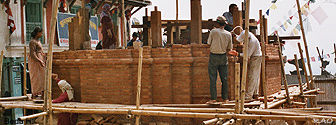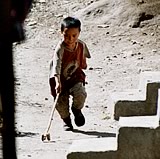|
| Human
Rights and Children |
|
|
|
| Human
Rights and Children |
 |
| Displacement
contributing to child labour problem |
 |
IRIN,
Report July 2005
|
 |
Programme
to eliminate child labour
KATHMANDU,
July 4, 2005
Ten
years ago, when Nepal signed an agreement with the International Labour
organisation (ILO) to launch a national programme to eliminate child labour,
there were real hopes that the scourge could be significantly reduced.
But today activists say that the number of working children in the Himalayan
kingdom has increased rather than gone down, in part because of the conditions
created by the current insurgency.
"The
conflict has had a serious negative impact on our past efforts, and the
challenges are enormous today," said long-time child labour activist, Uddhab
Poudel from ILO. Poudel added that as the insurgency forces more children
to leave their villages, the problem of child labour worsens.
It's
not only the number of working children that startles observers but the
kind of work they are increasingly being forced to undertake. Heavy migration
of displaced children into urban areas because of the nine-year long Maoist
conflict, means young people are being forced to engage in some of the
most dangerous and exploitative forms of labour."We
expect about 10,000 to 15,000 children to be displaced into urban areas
this year - this will grow by ten fold if the situation deteriorates,"
explained Poudel. "A peace settlement is the only way to protect our children
from further harm," he added.
|
Concern
for children has been mounting among activists working for children's rights.
In a report reviewing the situation in Nepal by the UN Committee on Rights
of the Child (CRC) in May, one of the committee experts, Lucy Smith, said
that Nepal was in many ways not a country fit for children.
According
to the Norwegian Refugee Council (NRC), many young children moving to urban
and semi-urban areas live in very difficult circumstances, being forced
to work in unhygienic conditions and in hostile environments. Many live
on the streets, denied an education and exposed to a variety of threats,
added the NRC.
A
recent Child Workers in Nepal (CWIN) report, said that child labour is
widespread in agriculture, manual work (such as carpet weaving) basket
making, iron and steel production, as well as industrial sectors such as
brick-making and stone quarrying. It added that most children are exploited
while employed as domestic helpers, hotel servants, porters or when picking
over rubbish looking for items to sell.
"Before
the conflict, children had the choice of returning home to their families
but now all they can do is keep quiet and do not have the power to bargain
with their employers," explained activist Tarak Dhital from CWIN. He added
that there was a dire need for contemporary research on the situation of
displaced children in the context of the current conflict.
Other
organisations, like Maiti Nepal, which focuses on reducing the number of
girls trafficked for prostitution, are concerned that the sexual exploitation
of children is also on the rise. This is especially the case amongst those
who end up in the capital and other main cities.
"Most
of them are in a vulnerable state and are without any protection as they
don't know where to approach for help," said Anuradha Koirala from Maiti
Nepal.
Nearly
two years have passed since the Children as Zone of Peace (CAZOP) initiative
was established to pressure both the rebels and security forces to leave
children out of the conflict. But activists maintain that both parties
have only made the situation worse for children, many of whom have been
the victims of constant abduction, interrogation, sexual abuse and physical
torture, leading them to flee their villages and work in exploitative conditions
in urban areas to survive.
"The
country is losing a whole generation of youth when they flee to India and
leave schools and live in hostile conditions without any certainty about
their future," said activist Reinhard Fichtl from Terre de Hommes, one
of the handful of NGOs that is planning to launch a project for internally
displaced Nepali children.
Fichtl
is worried that most organisations are only focusing on the IDP camps whereas
the large numbers of displaced children end up in the local district headquarters
near the villages.
"Most
live in cowsheds and whatever accommodation is available for the children,"
he explained. "Whenever we talk of civilians affected by conflict, we tend
to leave out children who are in need of most state protection from all
sorts of exploitation," Fichtl added.
Credit
IRIN 2005
Copyright
© UN Office for the Coordination of Humanitarian Affairs 2005
[
This report does not necessarily reflect the views of the United Nations]
Integrated
Regional Information Networks (IRIN), part of the UN Office for the Coordination
of Humanitarian Affairs (OCHA).
|
 |
| Links |
 |
 |
 |
External
Links |
|







